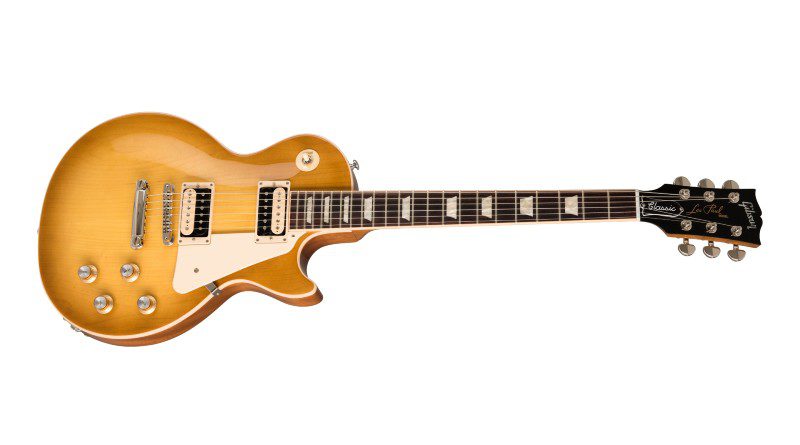The Gibson Les Paul is one of history’s most iconic instruments, and unsurprisingly, its legendary status has spawned countless imitations and “inspired by” copies of its timeless design. On the more sinister side of things, though, is the counterfeit market that has emerged in recent years. Despite the significant legal threats of the Gibson Corporation, several well-known websites infamous for peddling these knock offs have failed to cease and desist.
In this KillerGuitarRigs guide, we’ll be talking about who sells fake Gibson Les Pauls, what’s actually wrong with selling or buying them, and what are the red flags and giveaways that can help you identify a fake from an original. If you’re looking to buy a Les Paul, particularly a used one, this is a must read!
Contents
History and Popularity of The Gibson Les Paul
Since its original release in 1952, the Gibson Les Paul has become one of the most iconic guitars ever made, and its popularity among some of the world’s greatest musicians has only increased its cool factor.
Unfortunately, this fame comes at a price. Because of the high cost of originals, and the high demand for Les Paul guitars, a huge counterfeit market has emerged, resulting in thousands of knock offs floating around the market.
Who Sells Fake Gibson Les Pauls?
This is not an attempt to single out any particular nation, however, the vast majority of fake Gibson Les Paul guitars do come out of China. It’s not unheard of for them to appear from other far eastern countries, but large scale e-commerce websites hosted in China are rife with knock off Gibsons. In fact, it’s not just Gibson Les Pauls they sell – imagine any famous guitar, custom, special edition, relic’d, and you’ll find it on these websites.
The more you buy, the cheaper they get per unit, which makes them an attractive prospect to people looking to make a quick buck on eBay or Craigslist. But they don’t only sell to wholesalers, they’ll happily sell you just one of their fake Gibson Les Pauls, or “Chibson” Les Pauls, as they’re sometimes nicknamed.
What Is The Harm With Fake Gibson Les Pauls?
Some may claim that Gibson’s outlandish pricing structure fueled the rise of the fake Les Paul. After all, all but the most basic models are far out of the reach of the average working musician price wise. Others say that it’s marketing gone wrong – Gibson have fueled the desire to have that open book headstock on a guitar to such a point that vanity might drive some players to forego an Epiphone, which is likely of vastly superior quality, just to have a guitar that looks a bit like a Gibson (later you will learn why this isn’t always the case).
If someone is happy to look past the questionable labor, the stolen intellectual property, and the potential stigma of being called out on their knock off, then that’s on them. That is a conscious decision, not necessarily a good one, but one made of free will, nonetheless.
The big problem arises when somebody who isn’t well versed in how to spot a fake sees the deal of a lifetime on Craigslist or Marketplace for their dream Gibson Les Paul, only to later discover that it was a fake, and they have spent hundreds on a worthless counterfeit. Even worse, the players who pay what they think is fair market value for a Les Paul, potentially thousands of dollars, and it turns out to be a fake. These buyers did not purchase these instruments knowing that all they were buying was an open book headstock and some cheap components, and this is the real harm.When fakes circulate from the hands of the wholesalers and those who knew what they were buying, into the hands of the innocent guitar shopper, that’s where the real problem arises.
What Are The Signs That Suggest A Gibson Les Paul Is Fake?
Fortunately, the desire of the counterfeiters to make quick money outweighs their desire to properly research the instruments they are faking. Many of these fakes suffer from the very same inconsistencies and variations from an Original Gibson Les Paul, and that makes them relatively easy to spot. Please do remember that this guide is aimed at providing hints and tips on spotting fakes. There is no guarantee that a guitar lacking these telltale signs is not a fake. If a deal doesn’t feel right, it probably isn’t. If a bargain seems too good to be true, it probably is!
Truss Rod and Cover
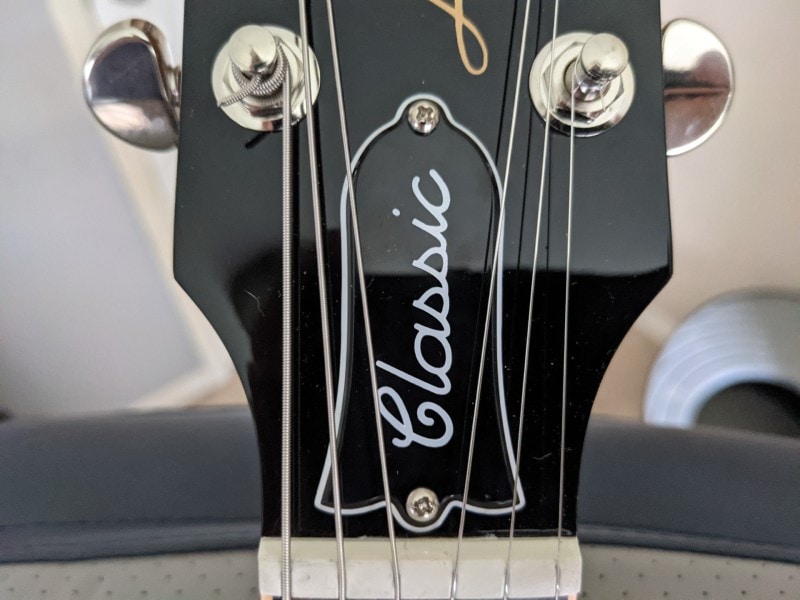
An easy first spot is the truss rod cover. A genuine Gibson Les Paul will only ever have 2 screws in the truss rod cover, and they should be vertically aligned, one at the top, one at the bottom. If it has 3 screws, no matter which orientation, it is almost certainly a fake. Gibson has never made a truss rod cover with 3 screws. Again, even if it only has the requisite 2 screws it may still be a counterfeit, you still need to look for the other telltale signs.
The cover should be made with quality plastics, and should have ultra smooth, well finished edges, and perfectly aligned text (if it’s a model with a truss rod cover inscription)
Under the cover, you should find a properly seated truss rod that offers a good amount of resistance, but still turns smoothly, without significant effort. The cavity should also be nicely finished, with no rough wood, and no paint overspray.
Headstock Logo and Branding
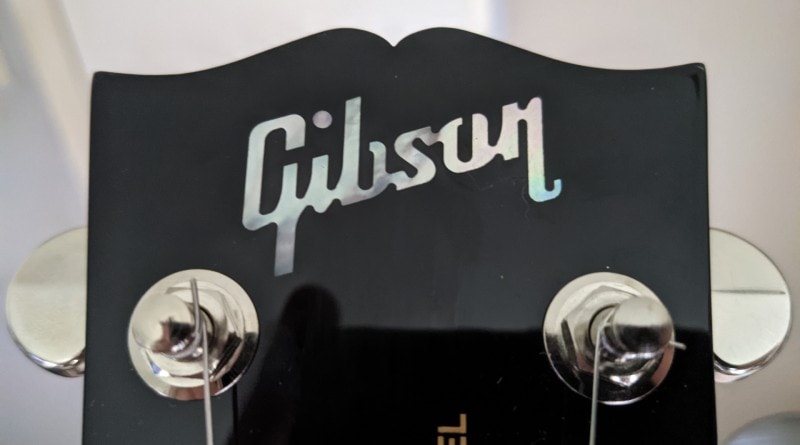
If you know anything about Gibson, you’ll know that they go to extreme lengths to protect their intellectual property, and their headstock design is one of the the things they’re most protective of.
The Gibson logo itself should be precisely cut if it’s inlaid, and if it’s painted, it should have clean, sharp edges and the correct font. Be sure to examine the thickness and color of the logo, and compare it to known originals. Les Pauls are extremely well documented guitars, so you shouldn’t have too much of an issue finding pictures of authentic versions of the same model. Counterfeit Les Pauls often miss these subtle details and end up with logos that are either too thick, too thin, or even off in color.
Additionally, authentic Les Pauls have a very specific script for the “Les Paul Model” text, which is finely printed and carefully positioned.
If anything about the logos or branding on the headstock is less than perfect, this is a significant red flag. Genuine Gibson headstock logos are always symmetrical and properly proportioned, so any irregularities here would be a strong indicator of a counterfeit.
Body Shape and Construction
Another indicator of authenticity in a Gibson Les Paul is the body shape and construction. At a quick glance, a lot of fakes look almost indistinguishable from the real thing, however, if you were to compare a real guitar and a counterfeit side by side, you’re likely to see incorrect proportions between the upper and lower bouts.
Pay particular attention to the lower bout of the guitar, which should have a very specific, smooth curvature. The cutaway is another area that counterfeiters tend to get wrong, either making it too deep or too shallow.
Another area to check is the headstock break angle, one of the most common areas that counterfeiters get wrong. In authentic models, the headstock is built with a very specific 17 degree break angle, while fakes tend to have a shallower break, most likely due to the high level of skill it takes to make the headstock join with the requisite strength. We’re not suggesting you get out a protractor when you’re shopping, but again, if you have access to a known original, you can compare a suspected fake to the genuine article and check the headstock angle.
Weight and Feel
Yes, Les Pauls are notoriously heavy, but if there’s one thing that isn’t consistent from guitar to guitar, even with originals, it’s the weight. Carved top models can range from around 8lb to as much as 14lb, but anything outside of this range is extremely rare. You’re more likely to find a fake that comes in underweight than overweight, so be wary of anything that feels too light.
The overall feel of the guitar is also super important. Does the balance feel right? Does the neck profile match the specs that Gibson lists for that particular version? Does the finish feel plasticky?
If the answer to any of those questions is no, you should think twice before purchasing. Real Gibson Les Pauls are extremely consistent from guitar to guitar when it comes to balance and neck profiles, and because all Gibson Les Pauls have nitro finishes, a hard, thick, plasticky feeling top coat is an indicator of a polyurethane finished fake.
Trapezoid Fret Markers
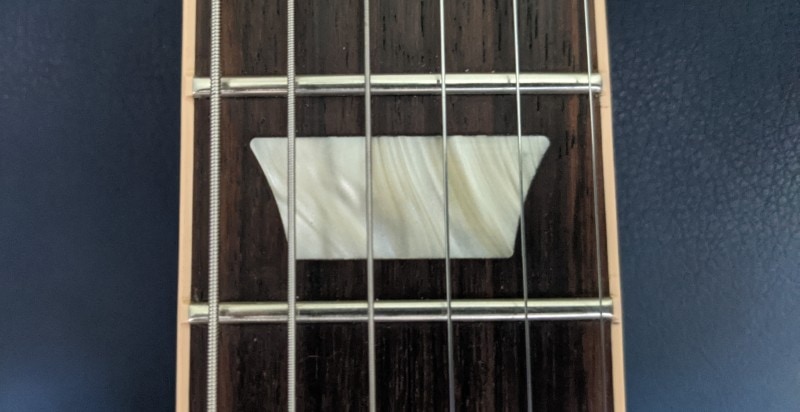
If the guitar you’re looking at has trapezoid or box markers on the frets, be sure that all horizontal lines are perfectly straight, and also that they are parallel to the frets. There is no way a real Gibson would ever pass quality control with less than perfect fret markers. If you find that they are crooked, jagged, or just not right in any way, this is not a guitar you should consider purchasing.
Hardware Details
The hardware on a Gibson Les Paul, including the screws, bridge, bridge posts and tuning pegs, is often a clear indicator of authenticity. Genuine Les Pauls use high quality hardware made from properly machined metals. Each component will be uniform and properly fitted, with well finished edges and no sharps or burrs.
The Tune-O-Matic bridge posts are another area that you will specifically need to inspect. A genuine guitar will have slim posts with a smooth, rounded head to it. If you see a Gibson Les Paul with a wide bridge post and large, flathead screw tops, there is a strong chance it isn’t genuine. If the guitar is being sold as brand new, it is definitely counterfeit, however, on a used guitar, there is always a chance that there have been aftermarket additions to a real instrument, so pay close attention to all of the signs.
Pickup Selector Switch
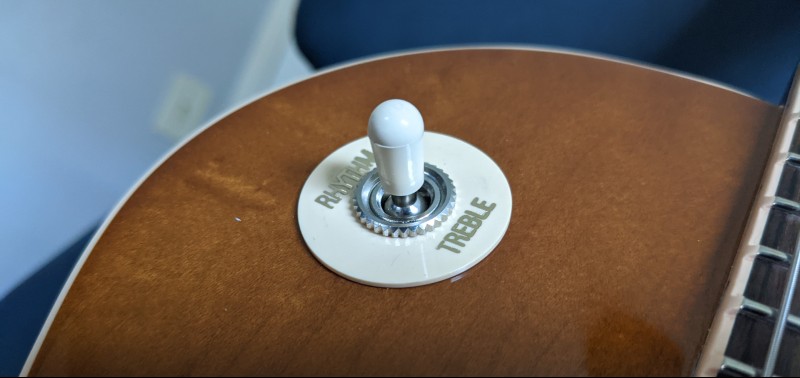
Pay close attention to the toggle switch. First, look at the securing nut. A genuine Gibson Les Paul always leaves the factory with a circular splined nut. Knock offs are often fitted with large hex nuts – if you see a hex nut, this is a definite warning sign. Counterfeits also often have excessively long toggle switches, and oversized poker chips – again, on used models, there is a chance aftermarket additions have been made, but you should be aware of these red flags.
Fret Nibs and Binding

One of the most prominent indicators of a genuine Gibson Les Paul is proper fretboard binding and nibs. Fret nibs are small extensions of the binding that cover the ends of the frets, providing the smoothest possible playing surface and giving them a uniquely Gibson look. Counterfeit models often miss out fret nibs, making this one of the most obvious things to look for, although this only affects models with bound fretboards.
We are aware of some custom “Chibson” makers who will fit fret nibs, but the quality of the work is generally pretty poor, and results in a bumpy feel.
Serial Number
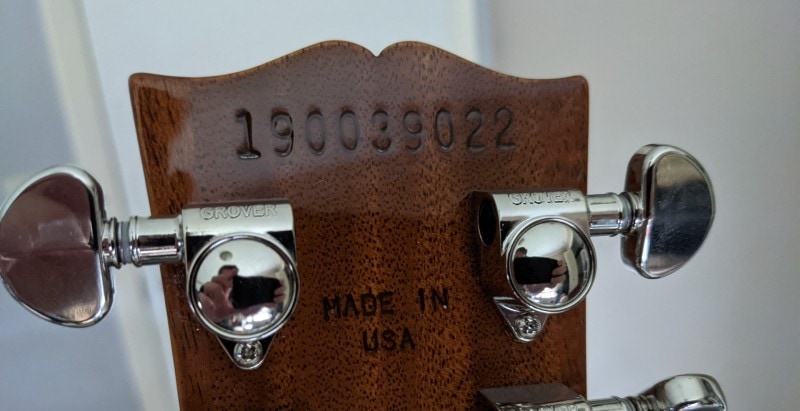
Counterfeiters have been able to successfully find real serial numbers to add to their fake instruments, but what they often stumble on is the application of those numbers. Genuine guitars have well defined, yet shallow numbering and lettering. The depth should be consistent, and the lettering should be properly squared and level. If you see a guitar with deep, poorly applied, or misaligned serial numbers, you should definitely avoid it as it’s most likely not genuine.
Additionally, fake Gibson Les Pauls are also known to have the serial numbers and the “Made in USA” markings filled in with paint. On an original, the finish on these markings will match the finish of the rest of the back of the neck and headstock.
Especially if you’re buying a used Les Paul, try to validate the serial number through Gibson’s website, or through a community run resource like the Guitar Dater Project.
Body Binding
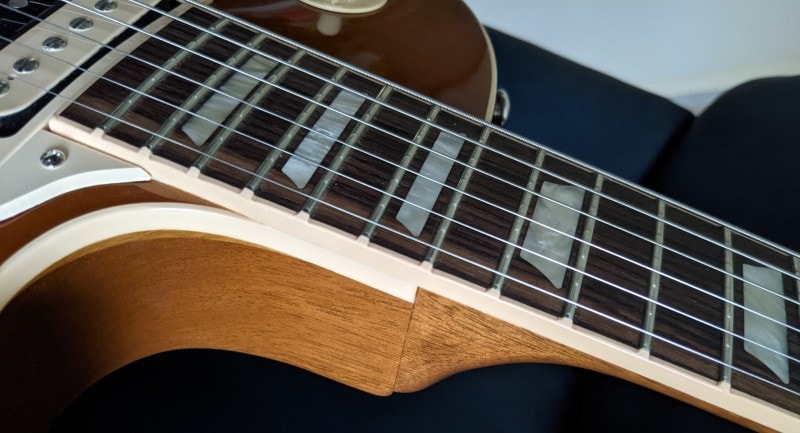
If you’re looking at a model with body binding, look carefully at the area where the horn meets the neck. The neck binding and the body binding should merge at this point. If there is a pronounced gap, this is another sign that the guitar you’re looking at may well be a counterfeit.
If you’re looking at an older model, the binding should be starting to yellow. If you’re looking at anything older than 5 years and the binding is pristine white, that’s a red flag.
Stoptail Position
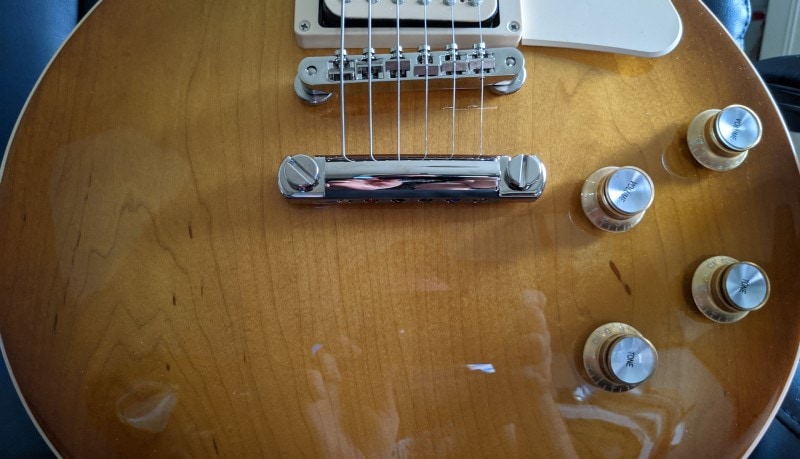
Next, look at the position of the stoptail. You need to establish whether the stoptail itself is closer to, or further away from the bridge than the neck volume knob. If you find that the stoptail is further from the bridge than the neck volume knob, you should probably avoid the guitar you’re looking at, as it’s likely a knock off.
Electronics and Wiring Harness
Producers of fake Gibson Les Pauls tend to do their worst work in the hidden areas. Inside the electronics cavity is a common place to find issues.
In order to minimize production costs, counterfeiters will almost always use the cheapest electronic components they can get their hands on. They know that serious players who intentionally buy their guitars will most likely change out the electronics, and those who don’t know what they’re looking for most likely can’t tell the difference.
Also, look at the branding on the pots. Gibson either uses their own in-house pots, or CTS brand. If the pots are plain, and especially if they are dime sized, this is a dead giveaway that the guitar isn’t genuine.
Finally, note that a real Gibson will have nice, tidy wiring, quality solder work, and will have the pots mounted on a plate. If there is no plate, and it’s not a vintage model, then you’re dealing with a fake.
Price and Seller Reputation
Finding a bargain Les Paul might feel like hitting the jackpot, but remember, these guitars hold their value extremely well, so an unusually low price should set alarm bells ringing. A guitar being sold as brand new shouldn’t be listed anywhere with anything more than a ~ $200 discount from the MSRP.
As for used guitars, check the likes of Reverb for comps. See what other people are selling the same model for, and take a good look at the pictures on those listings to see if they match the guitar you’re looking at. If you get the chance to see it in person, be sure to look at all the other points we’ve highlighted throughout this guide to assist in your authentication.
Final Thoughts On How To Spot A Fake Gibson Les Paul
Unless you’re buying your Gibson Les Paul brand new from a trusted retailer like Sam Ash, Sweetwater, or Guitar Center, you should always approach with a cautious eye. Even if it’s a friend selling the instrument, unless you know where they got it from, it could be the case that they also unwittingly purchased a counterfeit.
Craiglist, eBay, Facebook Marketplace, and Pawn Shops all over the country are awash with these replicas. Particularly if you see a brand new Gibson Les Paul retailing under MSRP, proceed with extreme caution, and avoid unless you’re absolutely certain on the authenticity, or you’re OK with the idea of potentially losing your money. Gibson rarely discounts guitars, so extremely low prices should always be a red flag.
Check out these other articles you might like:

